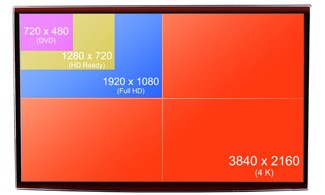
IT departments working in tandem with security professionals to fortify an organization’s computer network is commonplace for organizations to ensure that its bandwidth demands are able to sustain IP video surveillance systems consisting of many cameras and recording devices. In accordance with Moore’s Law, which roughly states that the computational power of a device doubles every year, security cameras over the last few years have become increasingly more advanced in their image capture and processing abilities. As a result, 4K technology has started to creep into consumers’ lives as advanced smartphone cameras and ultra-HD TV and monitor screens, leading some security professionals to wonder if IP cameras will also adopt the technology soon.
4K is still a slightly ambiguous term to denote digital video that is roughly 4000 pixels wide; While some distinctions of cameras (usually reserved for digital cinema) feature resolutions of 4096 x 2160, standard 4K IP cameras on the market are 3840 x 2160 pixels (similar to broadcast television standards). In fact, broadcast TV and consumer markets typically drive technological development of video transmission as evidenced by the eventual widespread adoption of 1080p HD content and displays that are commonplace today. It’s clear that progress will continue as the public’s interest in higher-quality content increases, but for the video surveillance industry, but there are still a few hurdles to overcome.
The most obvious benefit of 4K is superb picture quality. A benefit that may be less obvious to the uninitiated is the fact that 4K provides so many pixels in a display that the user viewing the picture is able to digitally zoom in on a scene without degradation of quality, effectively reducing the number of cameras needed for adequate surveillance coverage. Additionally, 4K displays provide similar advantages; if a surveillance system is only outfitted with 1080p full HD cameras, four frames are able to fit within the entire 4K monitor at a time without compressing the signal output, potentially reducing the number of displays needed (as shown to the right).
compressing the signal output, potentially reducing the number of displays needed (as shown to the right).
One of the largest challenges to 4K video surveillance adoption, mentioned earlier, is the burden it places on network bandwidth thanks to the high data rates attributed with 4K, highlighting the harsh fact that whatever works for todays’ networks may not work for tomorrow’s needs. Similar challenges include:
- With so many pixels to manage, 4K camera processors need to work harder to produce quality images in real time, especially in scenes with lots of color, detail, and movement. Concurrently, this also requires the need for extremely powerful computers with more processing abilities in order to decode the 4K stream.
- Transmitting such large video signals necessitate advanced cable engineering solutions to ensure reliability. Fiber is an option that provides some somewhat future-proof flexibility, but can be costly to install.
- Even if an expertly designed 4K video solution overcomes the previously mentioned obstacles, there is also the problem of enough storage; one hour of raw, uncompressed 4K video requires up to 110 gigabytes of space—almost 2 GB per minute.
In order to try to predict the future of 4K, it may help to look at the past; five years ago, HD TVs were abundant throughout living rooms across the country, but HD as the dominant format for security applications is a relatively recent development that continues to spread throughout the industry. It’s possible that by 2018—or earlier—4K will finally start to live up to the hype, after all the remaining pieces of the IP surveillance puzzle technologically evolve.
